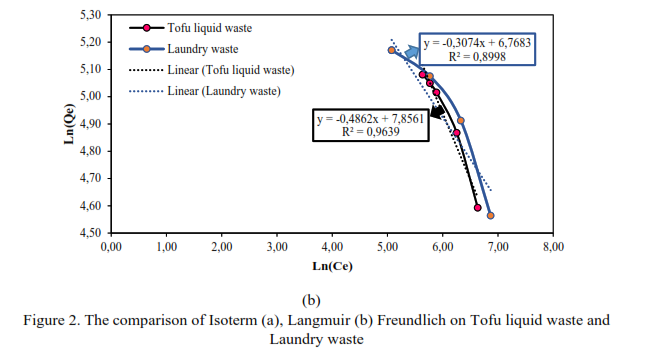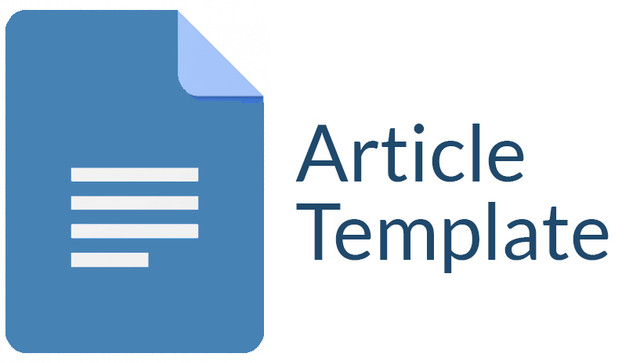Comparative Efficiency of KOH-Activated Rice Husk Carbon in Adsorbing Pollutants from Laundry and Tofu Wastewater
DOI:
https://doi.org/10.30736/seaj.v7i2.1254Keywords:
Wastewater treatment, Langmuir isotherm, Adsorption, Carbonization, Chemical activationAbstract
Comparative Efficiency of KOH-Activated Rice Husk Carbon in Adsorbing Pollutants from Laundry and Tofu Wastewater. This study aims to compare the adsorption capacity of rice husk-based activated carbon in overcoming pollution from two types of liquid waste, namely laundry waste and tofu liquid waste. The raw material of rice husk is processed through a carbonization process and chemical activation using potassium hydroxide (KOH), then used in a batch adsorption test. The parameters analyzed include Chemical Oxygen Demand (COD), Total Dissolved Solids (TDS), and Total Suspended Solids (TSS). The results show that the adsorbent material produced is able to reduce pollutant levels significantly. COD and TDS are more effectively reduced in laundry waste because the organic content and surfactants are more easily adsorbed, while TSS experiences a greater decrease in tofu waste due to the high suspended solids content. The adsorption process follows the Langmuir isotherm model with the regression values for both laundry and tofu wastewater of R2>0.9, which indicates the occurrence of monolayer adsorption on the surface. This biosorbent has proven to be economical, environmentally friendly, and has the potential to be applied on a small scale, especially for household industries such as laundry businesses and tofu production. In addition to being relevant for local contexts, this approach can also be adopted globally in areas with high rice husk availability and similar waste management problems.
Downloads
References
Ahmed, M. J., Hameed, B. H., & Hummadi, E. H. (2021). Insight into the chemically modified crop straw adsorbents for the enhanced removal of water contaminants: A review. Journal of Molecular Liquids, 330, 115616. https://doi.org/10.1016/j.molliq.2021.115616
Aichour, A., & Zaghouane-boudiaf, H. (2019). Highly brilliant green removal from wastewater by mesoporous adsorbents : Kinetics , thermodynamics and equilibrium isotherm studies. Microchemical Journal, 146(December 2018), 1255–1262. https://doi.org/10.1016/j.microc.2019.02.040
Andika, B., Wahyuningsih, P., & Fajri, R. (2020). Penentuan Nilai BOD dan COD Sebagai Parameter Pencemaran Air dan Baku Mutu Air Limbah di Pusat Penelitian Kelapa Sawit (PPKS) Medan. Quimica: Jurnal Kimia Sains Dan Terapan, 2(1), 14–22. https://ejurnalunsam.id/index.php/JQ
Badan Standar Nasional. (2019). SNI 06-6989-3-2019 tentang Cara Uji Padatan Tersuspensi Total (Total Suspended Solid) Secara Gravimetri.
Badan Standar Nasional. (2004). SNI 06-6989-27-2019 tentang Cara Uji Padatan Terlarut Total (Total Dissolved Solid) Secara Gravimetri.
Badan Standardisasi Nasional. (2009). Air dan air limbah – Bagian 73: Cara uji kebutuhan oksigen kimia (COD) secara tertutup. SNI 6989.73:2009. Badan Standardisasi Nasional.
Beyan, S. M., Prabhu, S. V., Sissay, T. T., & Getahun, A. A. (2021). Sugarcane bagasse based activated carbon preparation and its adsorption efficacy on removal of BOD and COD from textile effluents: RSM based modeling, optimization and kinetic aspects. Bioresource Technology Reports, 14(November 2020), 100664. https://doi.org/10.1016/j.biteb.2021.100664
Dewi, N. M., Maelan, N. M., Andini, S., & Perdani, M. S. (2024). Pembuatan Hidrogel Berbasis Carboxymethyl Cellulose ( CMC ) dan Pektin sebagai Adsorben Logam Cu dengan Metode Freeze-Thaw Preparation of a Carboxymethyl Cellulose ( CMC ) and Pektin-Based Hydrogel As an Adsorbent of Cu ( II ) Using the Freeze-Thaw Method. 6(2), 112–119.
Erawati, E., & Fernando, A. (2018). Pengaruh Jenis Aktivator Dan Ukuran Karbon Aktif Terhadap Pembuatan Adsorbent Dari Serbik Gergaji Kayu Sengon (Paraserianthes Falcataria). Jurnal Integrasi Proses, 7(2), 58. https://doi.org/10.36055/jip.v7i2.3808
Fakoya, T. O., Oyekunle, J. A. O., Adekunle, A. S., Oyinloye, A. J., & Ejidike, I. P. (2024). Removal of hexachlorocyclohexane isomers from wastewater using activated carbon from Musa paradisiaca peel: Adsorption isotherms, kinetic, and thermodynamic studies. Chemical Thermodynamics and Thermal Analysis, 15(August), 100140. https://doi.org/10.1016/j.ctta.2024.100140
Fisma, I. Y., & Bhernama, B. G. (2022). Analisis Air Limbah Yang Masuk Pada Waste Water Treatment Plant (Wwtp). Amina, 2(2), 50–58. https://doi.org/10.22373/amina.v2i2.496
Gonçalves, S. P. C., Strauss, M., Delite, F. S., Clemente, Z., Castro, V. L., & Martinez, D. S. T. (2015). Activated carbon from pyrolysed sugarcane bagasse: Silver nanoparticle modification and ecotoxicity assessment. Science of the Total Environment, 565, 833–840. https://doi.org/10.1016/j.scitotenv.2016.03.041
Harmiwati, N. H., Yahya, A. K., Luthfi, M. Z., Nurmalasari, E., Permadani, R. L., Aini, A. P., & Rahayu, P. (2024). Pengolahan Limbah Cair Industri Tahu Menggunakan Teknologi Ultrafiltrasi Dengan Sistem Monitoring Berbasis Internet of Things. Journal of Industrial Community Empowerment, 3(1), 25. https://doi.org/10.52759/jice.v3i1.253
Indah, D. R. (2020). Adsorpsi Logam Tembaga (Cu) Pada Karbon Baggase Teraktivasi Natrium Hidroksida (NaOH). Jurnal Ilmiah IKIP Mataram, 7(1), 12–26.
Jiyah, B.Sudarsono, A. S. (2017). Jurnal Geodesi Undip Januari2017. Jurnal Geodesi Undip, 6, 41–47.
Khairuddin, Ruslan, R., Tahili, M. R. A. M., Puspitasari, D. J., Indriani, Sosidi, H., Prismawiryanti, & Mirzan, M. (2022). Penurunan Kadar Chemical Oxygen Demand (COD) pada Limbah Cair Industri Tahu Menggunakan Arang Aktif dari Pelepah Kelapa Sawit (Elaeis guenensis Jacq.). KOVALEN: Jurnal Riset Kimia, 8(2), 171–177. https://doi.org/10.22487/kovalen.2022.v8.i2.15966
Kusniawati, E., Sari, D., & Mareska, P. (2023). PEMANFAATAN SEKAM PADI SEBAGAI KARBON AKTIF UNTUK MENURUNKAN KADAR pH, TURBIDITY, TSS, DAN TDS. 2(10), 4183–4198.
Lacalamita, D., Mongioví, C., & Crini, G. (2023). Chemical substances present in discharge water generated by laundry industry: Analytical monitoring. Water Science and Engineering, 16(4), 324–332. https://doi.org/10.1016/j.wse.2023.07.004
Lestari, D. I., Yuliansyah, A. T., & Budiman, A. (2022). Adsorption studies of KOH-modified hydrochar derived from sugarcane bagasse for dye removal: Kinetic, isotherm, and thermodynamic study. Communications in Science and Technology, 7(1), 15–22. https://doi.org/10.21924/cst.7.1.2022.669
Li, H., Liu, L., Cui, J., Cui, J., Wang, F., & Zhang, F. (2020). High-efficiency adsorption and regeneration of methylene blue and aniline onto activated carbon from waste edible fungus residue and its possible mechanism. RSC Advances, 10(24), 14262–14273. https://doi.org/10.1039/d0ra01245a
Luna, P., Hoerudin, Usmiati, S., & Sunarmani. (2020). Teknologi Pembuatan Adsorben Dari Limbah Ekstraksi Biosilika Sekam Padi. Pasundan Food Technology Journal, 7(3), 116–125. https://doi.org/10.23969/pftj.v7i3.3001
Kementerian Lingkungan Hidup. (2014). Peraturan Menteri Negara Lingkungan Hidup Republik Indonesia Nomor 5 Tahun 2014 tentang Baku Mutu Air Limbah. https://peraturan.bpk.go.id/Home/Details/134388/permen-lh-no-5-tahun-2014
Mefiana, R. M. (2021). Uji Efektivitas Karbon Aktif dan Abu Sekam Padi dalam Menurunkan Kadar BOD dan COD Limbah Cair Laundry. Jurnal Kartika Kimia, 4(2), 83–88. https://doi.org/10.26874/jkk.v4i2.87
Ningsih, L. M., Mazancová, J., Hasanudin, U., & Roubík, H. (2024). Energy audits in the tofu industry; an evaluation of energy consumption towards a green and sustainable industry. Environment, Development and Sustainability, 0123456789. https://doi.org/10.1007/s10668-024-05109-z
Safitri, D. I., Hendrawati, N., & Ramadhana, R. (2024). PEMANFAATAN TONGKOL JAGUNG DALAM PEMBUATAN KARBON AKTIF DENGAN AKTIVATOR NaOH DAN Na2CO3. DISTILAT: Jurnal Teknologi Separasi, 10(1), 113–121. https://doi.org/10.33795/distilat.v10i1.4939
Sailah, I., Mulyaningsih, F., Ismayana, A., Puspaningrum, T., Adnan, A. A., & Indrasti, N. S. (2020). Kinerja Karbon Aktif Dari Kulit Singkong Dalam Menurunkan Konsentrasi Fosfat Pada Air Limbah Laundry. Jurnal Teknologi Industri Pertanian, 30(2), 180–189. https://doi.org/10.24961/j.tek.ind.pert.2020.30.2.180
Sutama, K., Alfiana, A. F., Rizkita, N., Lestari, D. I., Nahdlatul, U., & Negeri, P. (2025). Adsorption of Tofu Liquid Waste Using Rice Husk Activated Carbon. 7(1), 94–107.
Sutama, D.K., & Megantara, D. (2018). Penyisihan Ion Sulfat Menggunakan Karbon Aktif dari Jerami Padi dengan Aktivasi ZnCl2. Sarjana thesis, Universitas Brawijaya. https://repository.ub.ac.id/id/eprint/11656/
Wang, J., Lei, S., & Liang, L. (2020). Applied Surface Science Preparation of porous activated carbon from semi-coke by high temperature activation with KOH for the high-e ffi ciency adsorption of aqueous tetracycline. Applied Surface Science, 530(June), 147187. https://doi.org/10.1016/j.apsusc.2020.147187
Wibowo, R., Mualiq, I., Studi, P., Mesin, T., & Kudus, U. (2017). Optimasi Proses Pirolisis Pada Pembuatan Briket. Jurnal Seminar Nasional Publikasi Hasil-Hasil Penelitian Dan Pengabdian Masyarakat, September, 315–318.

Downloads
Published
How to Cite
Issue
Section
License
Copyright (c) 2025 Daning Kinanti Sutama, Dwi Indah Lestari, Erina Endah Kusuma Wardani, Shaddiqah Munawaroh Fauziah, Aulia Firda Alfiana

This work is licensed under a Creative Commons Attribution-ShareAlike 4.0 International License.
Authors who publish with this journal agree to the following terms:
- Authors retain copyright and grant the journal right of first publication with the work simultaneously licensed under a Creative Commons Attribution-ShareAlike 4.0 International License that allows others to share the work with an acknowledgment of the work's authorship and initial publication in this journal.
- Authors are able to enter into separate, additional contractual arrangements for the non-exclusive distribution of the journal's published version of the work (e.g., post it to an institutional repository or publish it in a book), with an acknowledgment of its initial publication in this journal.
- Authors are permitted and encouraged to post their work online (e.g., in institutional repositories or on their website) prior to and during the submission process, as it can lead to productive exchanges, as well as earlier and greater citation of published work (See The Effect of Open Access).

This work is licensed under a Creative Commons Attribution-ShareAlike 4.0 International License.









